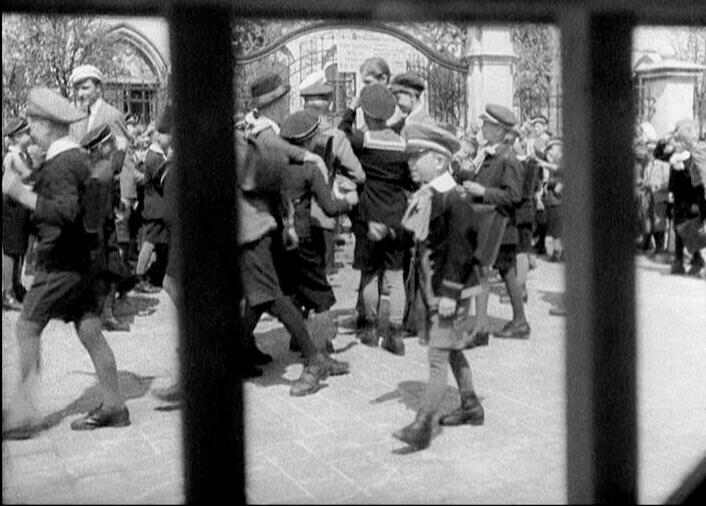
Die Feuerzangenbowle - (Germany, 1944)

Figure 1.--"Die Feuerzangenbowle" (The Flaming Punch Bowl) was made in NAZI Germany during 1944. This is a comic film set in Germany about 1910 in which a group of male friends gather at a
restaurant, the "Feuerzangenbowle", to enjoy each other's company and reminisce about their school days in a gymnasium or secondary school. They find that Hans never attended a regular school and they agree that he has missed an important childhood experience. The scene here looks to depict a scool in the 1910s, probably before the War.
|
|
"Die Feuerzangenbowle" (The Flaming Punch Bowl) was made in NAZI Germany during 1944. This is a comic film set in Germany about 1910 in which a group of male friends gather at a
restaurant, the "Feuerzangenbowle", to enjoy each other's company and reminisce about their school days in a gymnasium or secondary school. They find that Hans never attended a regular school and they agree that he has missed an important childhood experience. On a bet one of the men disguises himself as a student and is sent to the school. He then causees all sorts of amusing difficulties for the schoolmasters. He gets involved with schoolboy pranks. The scene here looks to depict a school in the 1910s, probably before the War (figure 1). Notice the caps. Boys commonly wore caps like this to school through the 1930s. For some reason they were no longer worn after Workd War II. The older students wear suits with long trousers in the school, but the younger boys (up to about age 13 or 14) wear short trousers with long stockings. Some of the boys wear
sailor suits. All of the boys regardless of age wear the peaked school cap. The costuming seems to be historically accurate except that the boys' stockings tend to be of various colors (brown, gray, beige, and black) whereas most boys of the time stuck mostly to black stockings.
Filmology
"Die Feuerzangenbowle" (The Flaming Punch Bowl) was made in NAZI Germany during 1944. The 1944 movie was directed by Helmut Weiss. Thec1944 production is considered a German comedy classic. It was one of last major productions of the NAZI-era film indusry at the end of World War II. It has gained cult status at German universities, probably because of the depictions of the professors. .
The Book
The film was based on a popular novel by Heinrich Spoerl published in 1933.
NAZI Film Making in 1944
Gernan had one of Europe's most important movue industry. Josef Goebbels as Minister of Propaganda took a special interest in movie making and female movie stars. While the studios continued to operate mich as befote , they were subject to various controls during the NAZI era. All Jews and NAZI critics were dimissed. Many fled the country and headed for Hollywood. For the most part Goebbels did not interfere a great deal, although he ordered some propaganda films made. And certain themes were forbidden such as films which wre seen as pascifist or anti-war. Many films were made without heavy-handed propaganda as was common in Soviet films. The War came home to Germany in 1944. The Allies strategic bombing campaign hammered away at German cities and by the end of the year the Allies had arrived at the borders of the Reich in both the east ahd west. Thus it became increasingly difficult to make films. And every film made had to be justified as contributing to the war effort. There was no good news for the German people. Goebbels insisted that the resources be made available for at least a few films. A film like this would have been justified as providing viewers a brief respite from the grim relatives of war. There was no reference to the War at all. It was nostalgic comedy to remind people of happier times and what was important to preserve.
This is a comic film set in Germany about 1910 in which a group of male friends gather at a
restaurant, the "Feuerzangenbowle", to enjoy each other's company and reminisce about their school days in a gymnasium or secondary school. They find that their friend, Dr. Johannes Pfeiffer who is an accomplished playwright, never attended regular school because he was educated at home. His friends agree that he has missed an important childhood experience. On a bet, Hans disguises himself as a student and is sent to the school. He then causees all sorts of amusing difficulties for the schoolmasterswho are sterotypical parodies and thus easy to lampoon. The protagonist gets involved with schoolboy pranks.
Setting
The scene here looks to depict a school in the 1910s, probably before World War I (figure 1).
Notice the caps. Boys commonly wore caps like this to school through the 1930s. For some reason they were no longer worn after Workd War II. The older students wear suits with long trousers in the school, but the younger boys (up to about age 13 or 14) wear short trousers with long stockings. Some of the boys wear sailor suits. All of the boys regardless of age wear the peaked school cap. The costuming seems to be historically accurate except that the boys' stockings tend to be of various colors (brown, gray, beige, and black) whereas most boys of the time stuck mostly to black stockings. The choice probably reflects what was available at the time. We note Gernan boys wearing long stockings in the 1940s, but black stockings were not very common. The Eton collars and floppy bows wre not very common after World War I in the 1920s.
HBC

Navigate the Boys' Historical Clothing Web Site:
[Return to the Main Movie Fm-Fz page]
[Return to the Main German movie page]
[Introduction]
[Activities]
[Biographies]
[Chronology]
[Clothing styles]
[Countries]
[Topics]
[Theatricals]
[Bibliographies]
[Contributions]
[FAQs]
[Glossaries]
[Images]
[Links]
[Registration]
[Tools]
[Boys' Clothing Home]
Created: 4:22 AM 5/21/20074
Last edited: 4:18 AM 10/13/2009



